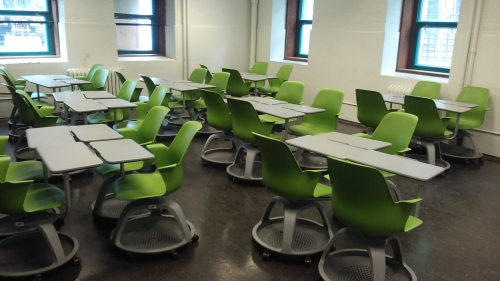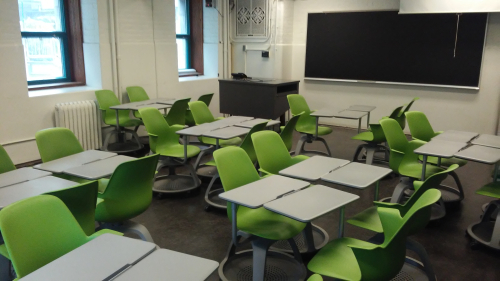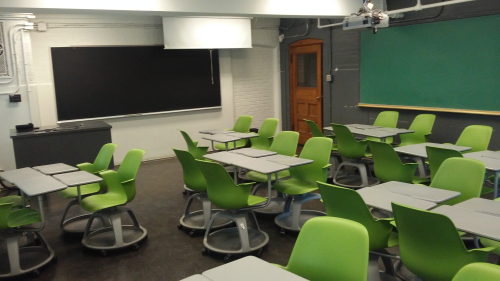- Location: 815 Sherbrooke Street West, Montreal, QC
- Capacity: 28 students
- Type: Flat classroom
Alignment with Principles for Designing Teaching and Learning Spaces
Academic Challenge
Promote individual, active engagement with content.
Layout
Oversized tablet work surfaces attached to chairs provide ample space for classroom materials (e.g., notebooks, laptops, textbooks). Mobile furniture permits rapid room reconfiguration for different learning activities.
Acoustics: Acoustic design mitigates distraction from outside and inside sources.
Furniture
Chairs on wheels permit students to work individually or in groups.
Technologies
Access to resources: Learning Management System, internet (via student laptops). Power outlets allow students to keep their computers charged during class.
Lighting & Colour
Appropriate natural and overhead lighting for individual work.

Learning with Peers
Promote active engagement with one another.
Layout
A flexible layout permits students to collaborate with one another and configure the space in multiple ways, moving easily from small group (groups of 2-4 students where the chairs’ tablets together make a table surface) to larger group activities.
Acoustics: Sound zones support multiple simultaneous conversations among students.
Furniture
Comfortable chairs on wheels permit students to turn to discuss and work with those next to or behind them, and allow for reconfiguration of the classroom to support a variety of collaborative learning approaches.
Technologies
Shared workspaces include multiple blackboards.
Lighting & Colour
Appropriate natural and overhead lighting gives ample light for group work; green chairs bring an energizing accent colour to this space.

Experiences with Faculty
Promote interaction and communication.
Layout
Instructor is not limited to the “front of the room” and instead has access to all students due to easily mobile furniture.
Acoustics: Sound zones ensure that not only are students able to hear the instructor, but that the instructor is also able to hear the students.
Furniture
The podium provides ample space for all instructional materials, and has a height adjustment for accessibility and convenience. Mobile furniture for students supports different teaching strategies.
Technologies
A data projector permits display of different learning materials.
Lighting & Colour
Brightly coloured chairs help to provide a welcoming ambiance in the room.

Contributions to the Campus Environment
Classrooms that incorporate elements of active and collaborative learning are part of a vision for a variety of flexible campus learning spaces. This classroom is designed for all populations using the space: well-lit, with a standardized room control panel that simplifies instructors’ use of equipment in classrooms across campus. IT is consistent with teaching and learning needs, and durable furniture contributes to sustainability efforts. Both physical and virtual affordances help maximize High Impact Practices (HIPs) for student learning within and beyond this classroom.
